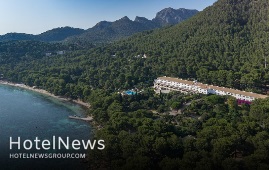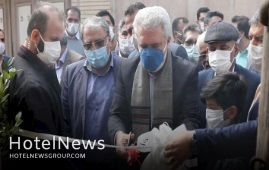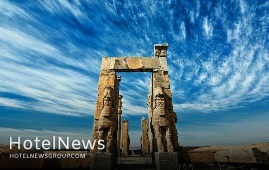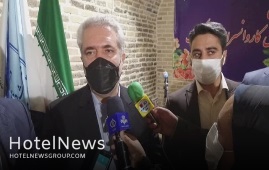
Over the past years, Tehran’s Vali-e Asr Street, famed as the longest in West Asia, has undergone countless maintenance works as a prerequisite for a possible UNESCO registration. The leafy street runs for over 17 kilometers from the railway station in the south of the metropolis to the Tajrish square in the north. It is lined with many shops, restaurants, parks, cinemas, and cultural centers. Tehran’s District 11 Mayor Nasrollah Abadian has recently talked about restoration works is has carried out on the southernmost section of the thoroughfare, which is situated in the district. “Vali-e Asr Street, which is the longest in West Asia, has undertaken extra maintenance and restoration works as a prerequisite for a possible UNESCO registration…. Four Kilometers of it is situated in the district 11 and others in the districts of 6, 3, and 1, respectively,” Abadian said. Landscaping and the beautification of urban spaces, flooring, and the protection of green spaces of the street are amongst tasks being practiced, he explained. “Vali-e Asr Street is the best example which witnesses the persistent exercises of creating the concept of Garden-Street as a destination of an urban area from the Safavid era up to the modern time,” according to the UNESCO website. “A variety of architectural styles from traditional to modern and eclectic is a representation of eastern and western values synthesis in a specific geographical point, which carries a true definition of an architectural and spatial place.” In the 19th century, the route once passed through Shemiran gardens, barren fields between Tehran and Shemiran, Yusef Abad, Abbas Abad, and Behjat Abad ending at its southernmost tip inside the then Qajar-era town of Tehran. Vali-e Asr Street, which is registered on Iran’s National Heritage list, was added to the UNESCO’s temporary list in 2019. The street is one of the main urban elements of the Iranian capital in the north-south direction.
Create: Apr 5, 2021 Edit: Apr 5, 2021 Regional News
Four Seasons Hotels and Resorts, a global leader in luxury hospitality, and Emin Capital, a private equity investment company focused on hospitality and real estate, announce plans for Four Seasons to manage the former Hotel Formentor in Mallorca, Spain. Originally opened in 1929, the existing hotel will undergo extensive renovations before it is unveiled as a Four Seasons experience in 2023. The property will offer 110 rooms and suites and is located on a 1,200 hectare (3,000 acre) plot of the Formentor Peninsula, offering access to a pristine beach, as well as a functioning vineyard a short five-minute drive away. “Following our entry into Spain in 2020, we are very excited to continue this momentum and expand our presence in this important market with a resort in Mallorca, offering guests a unique Four Seasons experience in a top European destination,” says John Davison, President and CEO, Four Seasons Hotels and Resorts. “It is a privilege to work alongside Emin Capital to create a new vision for this exceptional property and we look forward to a successful partnership for many years to come.” “Formentor is a landmark of Mallorca in a key and unique setting in the Mediterranean. For Emin Capital, the goal of our investment was to protect both, and to reinvigorate the resort with a great luxury brand such as Four Seasons. We are committed to implementing sustainable and green initiatives in our revitalisation of this property, while maintaining an exceptional design, facilities and renowned service,” added Jordi Badia, Chairman and CEO of Emin Capital. Mallorca, the largest of the Balearic Islands in the Mediterranean, can be accessed via ferry or a short flight from Barcelona, with additional direct flights from many European cities. Mallorca’s natural beauty and easy accessibility long established the island as a top tourist destination for European and international travellers. Mallorca’s turquoise waters, limestone cliffs and lush greenery make the picturesque island one of the world’s most sought-after destinations. About the Upcoming Four Seasons Resort in MallorcaLocated an hour away from Palma de Mallorca Airport, the upcoming Four Seasons in Mallorca will offer something for everyone through its extensive culinary offerings, relaxing spa facilities and exclusive seaside activities as one of the only properties in the area with direct beach access. All of the 110 rooms and suites will offer balconies with sea and forest views, allowing guests to soak in their beautiful surroundings. The renovations will be overseen by architects Estudio Lamela and SCT Estudio de Arquitectura, with interior designs by Gilles & Boissier. At the vineyard a short five-minute drive from the Resort, guests can enjoy exclusive programming, including farm-to-table activities. The Resort will also include an indoor restaurant, beachfront restaurant and café, and a poolside bar and grill. Additional onsite activities will include tennis courts and beautiful spa facilities. The Resort will also be the perfect choice for those planning meetings, events, weddings, and incentive travel, offering three event spaces as well as outdoor options to take advantage of the natural landscape. The project has been designed to respect and protect its natural surroundings through various environmental initiatives, such as the restoration of native vegetation and planting, reduced water consumption, rainwater harvesting and the use of grey water for landscape irrigation, heat recovery systems, solar power through use of solar panels, and food waste management systems. Other initiatives include the use of electric vehicles and low energy consumption through a very considered design approach. Four Seasons new project in Mallorca will become the second Four Seasons offering in Spain following the recent opening of Four Seasons Hotel and Private Residences Madrid in September of 2020.
Create: Mar 20, 2021 Edit: Mar 20, 2021 International News
Hilton Alpharetta Atlanta, an eight-story, 249-room full-service hotel in the heart of the Windward Business District, minutes from Avalon Boulevard, Downtown Alpharetta and Ameris Bank Amphitheatre, is the latest addition to Hilton Hotels & Resorts, one of Hilton’s 18 market-leading brands. Chartwell Hospitality opened the full-service hotel in the Windward Business District, a future mixed-use development at the corner of Windward and Northpoint Parkways, offering both guests and locals a sleek and contemporary escape. “Located in the heart of the Alpharetta Windward Business District, the hotel’s location paired with its modern design make it a perfect addition to our portfolio. Over the years, Alpharetta has evolved into a thriving business center, and we have seen an increase in visitors looking for modern new hotel options,” said Rob Schaedle, president, Chartwell Hospitality. “We look forward to delivering an exceptional level of service for all guests who enter its doors.” Additional hotel features and amenities include: AccommodationsOffering convenient access to Downtown Alpharetta and a short drive to Atlanta’s top attractions, the eight-story hotel is home to bright and spacious rooms featuring a modern design with locally sourced artwork adorning guest room walls. Guests at the Hilton Alpharetta Atlanta can look forward to upgraded guest rooms and more. The hotel’s stunning glass lobby, fireside nooks, Executive Concierge level and rooftop terrace elevate our guests to a unique VIP experience. All rooms and suites feature a 49-inch flat screen HDTV, large marble bathrooms, a selection of premium bath products and access to the hotel’s seasonal pool, cabana bar and 24/7 fitness center. DiningHärth restaurant and its flatbread oven will become the anchor of the public area of the hotel, just as the heart of a home is centered on the kitchen. Härth’s menu celebrates American comfort foods while bringing a fresh, contemporary approach to dining. Härth lounge offers the perfect location to unwind and relax, featuring specialty cocktails and light bites. Indoor and outdoor seating is available, along with a private dining room for more intimate gatherings. AmenitiesGuests seeking exercise or relaxation have a variety of options, including: 24-hour fitness center with Precor® equipment and free weights; heated seasonal pool with sunning terraces, cabana bar; and easy access to Big Creek Greenway scenic running/biking paths just a few blocks away. Meetings & EventsWith 6,500 square feet of meeting space, Hilton Alpharetta Atlanta’s meeting and event attendees can choose from our ballroom and breakout rooms, or an executive boardroom, perfect for intimate executive meetings and larger social gatherings. Offering glistening chandeliers, locally sourced art and artistic lighting [JFB1] options in our event foyer to set the backdrop for your next event. Meetings and events are all backed by Hilton EventReady with CleanStay, providing curated solutions for groups, with creative food and beverage, thoughtful technology resources, redesigned spaces for physical distancing, and reimagined ways to meet and gather to create a safe and comfortable environment for event planners and their attendees. Guests visiting Hilton Alpharetta Atlanta will enjoy peace of mind from check-in to check-out with Hilton CleanStay to enjoy an even safer and cleaner stay. New procedures include contactless digital check-in, and a Hilton CleanStay room seal to indicate that the room has not been entered since being thoroughly cleaned. Hilton Alpharetta Atlanta is also part of Hilton Honors, the award-winning guest-loyalty program for Hilton’s 18 distinct hotel brands. Members who book directly have access to instant benefits, including a flexible payment slider that allows members to choose nearly any combination of Points and money to book a stay, an exclusive member discount, free standard Wi-Fi and the Hilton Honors mobile app. Hilton Alpharetta Atlanta is located at 5775 Windward Parkway, Alpharetta, GA 30005 just 35 miles from Hartsfield Jackson Airport.
Create: Mar 16, 2021 Edit: Mar 16, 2021 International News
Head of the Iranian Tour Operators Association Ebrahim Pourfaraj has asked the government to issue tourist visas for the international applicants who have been fully vaccinated against COVID-19. “The Ministry of Health and the National Headquarters for Coronavirus Control can at least agree that the international tourists who have received the [second dose of] coronavirus vaccine would be allowed to enter Iran,” Pourfaraj said. He also lamented that the continuation of such a trend would result in losing international tourist markets more than before. “Or at least they should make it clear so that we can respond appropriately to foreign companies and tourists to not to miss the international tourist markets more than before.” Earlier this month, he said that the reasonable prices of Iran tours are expected to bring back the boom into the tourism sector of the country in the post coronavirus era. “Attractive tour plans are also being prepared for those who are eager to explore the historical attractions and natural wonders of the ancient country and want to experience a vacation here,” Pourfaraj said. He also expressed hope that international tour operators and companies who have worked with their Iranian counterparts for years, would put Iran back on the world’s travel route again, considering the facilities they can get at cheaper prices than in other countries. Referring to health tourism as a popular branch in Iran, he noted that medical services in Iran are provided at a lower price than what may be offered at double the price in other countries. Back in January, he announced that the tourist flow from across the world to Iran will return to normal in 2022. Although there are requests for traveling to Iran in the current year (2021), most travel agencies and tour operators believe that the flow will go back to normal in the next year, he explained. “Beginning mass vaccination against the coronavirus will provide better and safe conditions for international travels in 2022.” Last November, the World Tourism Organization announced that international tourist arrivals to Iran plunged 72% during the first eight months of 2020 when compared to 2019, highlighting the severe impact of COVID-19 as the main factor. Cultural Heritage, Tourism, and Handicrafts Minister Ali-Asghar Mounesan in October warned that Iran’s cultural heritage and tourism will be in a critical situation if the crises caused by the outbreak of the coronavirus continue. Last August, Mounesan said that Iran’s tourism has suffered a loss of 12 trillion rials (some $2.85 billion) since the outbreak of the coronavirus pandemic. Furthermore, the minister also noted that the coronavirus pandemic should not bring traveling to a complete standstill. “Corona is a fact, but can the virus stop tourism? Certainly not. For us, the coronavirus is a new experience in dealing with crises that teaches tourism experts around the world how to deal with such a disaster, and thankfully governments are turning this into an opportunity for better planning.” Smart and responsible traveling should replace "do not travel” recommendations, the minister stressed, adding: “In our country, Corona has caused problems in the tourism industry and the worrying point is the continuation of this trend.” “We are well aware of what the National Headquarters for Coronavirus Control proclaims [the health protocols], hence as a proposal, we have formulated some smart, responsible travel packages by the implementation of which we could have secure travels,” the minister said. He has repeatedly announced that his ministry is in full coordination with the Ministry of Health for strictly implementing health protocols in travel destinations, hospitably centers, and museums, amongst others, underlining that “people’s health is our priority.” The ancient land embraces hundreds of historical sites such as bazaars, museums, mosques, bridges, bathhouses, madrasas, mausoleums, churches, towers, and mansions, of which 24 being inscribed on the UNESCO World Heritage list. Under the 2025 Tourism Vision Plan, the country aims to increase the number of tourist arrivals from 4.8 million in 2014 to 20 million in 2025.
Create: Mar 16, 2021 Edit: Mar 16, 2021 Regional News
As you are well aware, medical tourism is booming worldwide as about 20 to 24 million people are traveling for medical treatments annually. Factors such as increased care needs over longer lifespans, rising healthcare costs, and constant pressures on some insurance industries are reasons behind why some opt to travel abroad. Regarding price competitiveness, Iran currently ranks first in the world but the country has not been very successful in attracting potential travelers as other competitors like Singapore and Turkey. People from the Persian Gulf littoral states, Iraq and Syria as well as Iranian expatriates residing in Canada and Germany constituted the majority of medical travelers to the Islamic Republic, who received plastic, cosmetics, open-heart, and orthopedic surgeries amongst other treatments over the past couple of years. A recent study co-authored by Iranian researchers Khalil Momeni, Ali Jannati, Rahim Khodayari-Zarnaq, Shabnam Ghasemyani, and Mohamadreza Havasian, suggests the main difference between Iran other countries they selected for the study lies in the organizational structure of the main stakeholders of the tourism industry; in other countries, this industry is organized and supervised by specific coordination bodies. Data were gathered from databases, including PubMed, Web of Knowledge, Scopus, Magiran, SID, and websites of the World Tourism Association, the Ministry of Tourism, and the Ministry of Health of the selected countries from 2000 to 2020. The study was published in the Melbourne-based Healthscope, which operates private hospitals, medical centers, and international pathology services. Six countries were selected purposefully, including Singapore, Turkey, Costa Rica, Jordan, United Arab Emirates, and Iran. They were compared in terms of the status of tourism and travel competitiveness, governance and policy-making status, the status of the medical tourism industry, and medical tourism infrastructure. In terms of tourism and travel competitiveness, Singapore, with a global rank of 17, was better than other countries. Based on the status of the medical tourism industry, Costa Rica ranked 7th in the world, and Singapore, the UAE (Dubai), Turkey, UAE (Abu Dhabi), Jordan, and Iran ranked 15, 22, 27, 31 35, and 41, respectively. In Iran, all indicators of medical tourism infrastructure were lower than those of other countries except for competitive prices. Comparative tables involved components, such as general profile, tourism and travel competitiveness, governance and policy, the status of the medical tourism industry, and medical tourism infrastructure in selected countries. The framework analysis based on the identified components was used to analyze the data. Furthermore, the study has confirmed that despite the legal framework for medical tourism development in Iran, this industry is currently facing several challenges. “These challenges are lack of specific medical tourism structure at the international, national, and regional levels, the lack of a medical tourism system, definition and formulation of laws, policies, and plans, the lack of infrastructure, and the lack of supervision system.” All of the indicators in tourism and travel competitiveness are low in Iran except pricing, which is ranked as the first cheapest country in the world. The growing medical tourism industry requires the optimal provision of all tourism infrastructures and not only the promotion of different indicators, the study suggests. Based on the report of the Medical Tourism Organization, the UAE, Turkey, and Jordan are the three most important destinations for medical tourism in West Asia. Even though Iran has good conditions in terms of competitive price, presence of skilled physicians, and low waiting time among the studied countries, but other medical tourism infrastructures are not enough invested. For example, until 2017, Iran has not been able to obtain a JCI license even for one hospital, and the average per capita physician/nurse index is much lower than the global one. To promote medical tourism, it is necessary to recognize the strategic medical tourism status of each province in the country, supply a specialized workforce, provide high-quality services, improve infrastructure, and promote a positive attitude of authorities to support the medical tourism industry. The study has also found that factors that can play a positive role in the development of medical tourism in Iran are advanced services for infertility treatment, cosmetic and dental surgery, organ transplantation and cell therapy, cultural similarity and familiarity with neighboring countries, and competitive prices. Measures, such as improving human resource communication skills and developing private hospitals following international standards, can also be effective in developing medical tourism. The main difference between the selected countries and Iran lies down in the organizational structure of the main stakeholders of the tourism industry. The study showed that one of the challenges for growing medical tourism in Iran is the presence of different organs of political and decision-making, as well as the cultural and political conditions. In all other countries, this industry is organized and supervised by specific coordination bodies. The revise of coordinating policies and strategies between various ministries, other government bodies, the private sector could help facilitate cross-sectoral coordination in this area. One of the important factors in the development of the medical tourism industry is the focus on attracting tourists from neighboring countries. Generally, certain populations are attracted more to certain locations. This might be due to a similar ethnic and cultural background. “To increase Iran’s ability to compete with countries in the region, such as Turkey, in attracting medical tourists, long-term plans should be developed to strengthen the infrastructure and cultural reforms, increase private sector participation and plan for the efficient use of mass media and local press for raising awareness. This requires a national effort and redefining the role of health tourism in the economy, as well as a strong trustee to follow up these measures,” the study suggests. According to the authors, the strengths points of the present study are the comprehensiveness of the selected countries and obtaining systematic information according to the appropriate strategy search. One of the limitations of the study is that in many items, the existing indicators are not updated, and some of the documents were in languages other than English and Persian. The Islamic Republic has set goals to exceed its yearly medical travelers to around two million in [calendar year] 1404 (March 2025-March 2026). Amongst Iran’s trump cards are the presence of credible surgeons and physicians, cutting-edge medical technologies, high-tech medicine and diverse specializations, super affordable procedures, and finally its hospitable people.
Create: Mar 13, 2021 Edit: Mar 13, 2021 Regional News
Iran will set aside ten billion rials (some $240,000 at the official exchange rate of 42,000 rials per dollar) for the restoration of the Great Wall of Gorgan, Cultural Heritage, Tourism and Handicrafts Minister Ali-Asghar Mounesan said on Sunday. Situated in the city of Gorgan, the capital of northern Golestan province, the defensive wall is about 200 km in length, and it was built to prevent the invasion of the northern tribes. It is said to be the longest architectural work of ancient Iran, which was built in 90 years. “We will allocate one billion tomans (ten billion rials) of credit for the restoration of the Great Wall of Gorgan, so that with this credit, the measures for the restoration of this wall, along with aerial imaging and mapping, will be carried out as preliminaries for [the possible] UNESCO registration,” Mounesan said. The minister made the remarks in a meeting with provincial officials and cultural figures during his visit to the lush green province. Last December, Mounesan’s deputy for cultural heritage, Mohammad-Hassan Talebian, said: “Gaining a UNESCO tag for the Great Wall of Gorgan -- one of the longest brick barriers of the ancient world -- is not hard as it is comparable to the Great Wall of China in terms of age, function, and size.” Although there are some issues and obstacles, further efforts to preserve and restore the millennia-old wall could be an acceptable justification for UNESCO to add this structure to the World Heritage list, Talebian explained. To get to that point, complete and accurate mapping of the remnants of the wall is needed, for which a budget of 20 billion rials ($476,000 at the official rate of 42,000 rials) has been allocated so far official added. He also noted that if the mapping project comes to an end by the end of the current Iranian year 1399 (March 20, 2021), the inscription of the wall on the World Heritage list would be discussed and possibly approved by the end of the next summer. Also known as Red Wall, which in some ancient texts is referred to as the Red Snake, this wall is the longest brick ancient barrier between Central Europe and China, longer than Hadrian’s Wall and the Antonine Wall put together and the third-largest wall in the world after the walls of China and Germany. Most parts of the gigantic monument are still hidden underneath the surface through some segments that have so far been unearthed and even restored to former glory. Archaeological excavations have so far identified ditches, brick kilns, earthen dams, water canals, 38 forts, and watchtowers attached to the wall, and more than 25 castles in the southern margin of the wall as well as several ancient sites from prehistoric, historic, and Islamic eras. The gigantic barrier is also more than three times the length of the longest late Roman defensive wall built from scratch, the Anastasian Wall west of Constantinople. The combined area of the forts on the Gorgan Wall exceeds that of those on Hadrian’s Wall about threefold. According to UNESCO, the Gorgan Wall is remarkable not only in terms of its physical scale but even more so in terms of its technical sophistication. To enable construction works, canals had to be dug along the course of the defensive barrier to provide the water needed for brick production. These canals received their water from supplier canals, which bridged the Gorgan River via qanats. One of these, the Sadd-e Garkaz, survives to 700 m in length and 20 m in height but was originally almost one kilometer long. The Gorgan Wall and its associated ancient military monuments provide a unique testimony to the engineering skills and military organization of the Sassanian Empire. They help to explain its geographic extent, from Mesopotamia to the west of the Indian Subcontinent, and how effective border defense contributed to the Empire’s prosperity in the interior and its longevity. These monuments are, in terms of their scale, historical importance, and sophistication, of global significance. Golestan is reportedly embracing some 2,500 historical and natural sites, with UNESCO-registered Gonbad-e Qabus – a one-millennium-old brick tower – amongst its most famous.
Create: Mar 9, 2021 Edit: Mar 9, 2021 Regional News
Cultural Heritage, Tourism, and Handicrafts Minister Ali-Asghar Mounesan inaugurated a hotel and two traditional guesthouses during his visit to the central city of Kashan on Tuesday. A budget of five trillion rials ($119 million at the official exchange rate of 42,000 rials per dollar) has been allocated for the establishment of the hotel, which is estimated to generate 120 job opportunities, CHTN reported. The total budget for traditional guesthouses also amounts to 170 billion rials ($4 million), the report added. The guesthouses are expected to create 40 new jobs as well. There is an additional 160 beds to the hospitality sector in the city with the inauguration of the accommodation centers. Kashan is a historical city near Isfahan in the central part of Iran. Its history dates back to over ten thousand years ago, and it is home to some of the most beautiful buildings featuring Islamic architecture. Many travelers opt to pass Kashan on their journeys between Tehran, Isfahan, Shiraz and Yazd, because this delightful oasis city on the edge of the Dasht-e Kavir, is one of Iran’s most alluring destinations. Kashan not only boasts a cluster of architectural wonders, an atmospheric covered bazaar, and a UNESCO-recognized garden, but it also offers some of central Iran’s best traditional hotels. The annual Golab-giri (rosewater distillation) ceremony of Kashan attracts huge crowds to the city every year. Some of the most ancient traces of civilization have been discovered near Kashan, at the Sialk archeological site.
Create: Mar 7, 2021 Edit: Mar 7, 2021 Regional News
Wyndham Hotels & Resorts (NYSE: WH) – the world’s largest hotel franchising company with over 8,900 hotels across nearly 95 countries and territories – announced today the first groundbreaking of its new La Quinta and Hawthorn Suites dual-brand hotel concept in Pflugerville, Texas. This marks the first-ever pairing of these two flags under the same roof and enables owners to target both the business transient and extended-stay demand within any given market. The company has 36 La Quinta and Hawthorn dual-branded hotels in its development pipeline in markets such as San Antonio and El Paso, Texas; Yuma, Ariz.; Wichita, Kan.; Charlotte, N.C. The property is slated to open in March 2022 with a combined 100 guestrooms – 30 of which will feature the recently updated Hawthorn room design that includes modern, well-equipped kitchens for extended-stay guests. This hotel will also feature the newly refreshed room design from La Quinta’s sought-after Del Sol prototype in 70 rooms. This new dual-brand hotel concept is designed to streamline development and operational costs. The concept includes a shared lobby, spacious modern great room, fitness center, bar, amenities, and back of the house all while appealing to the multiple types of travelers that have an affinity for these brands. The combination enhances Wyndham’s suite of offerings for developers by coupling its leading upper-midscale brand, La Quinta, with its benchmark, extended-stay Hawthorn Suites brand that reported a 44 percent year-over-year increase in domestic contract executions during 2020. Conveniently located at Pflugerville’s Stone Hill Town Center, just 15 miles northeast of Austin, the hotel provides easy access to the area’s more than 1,000 acres of scenic parks, trails and open spaces. The growing suburb of Pflugerville has seen significant business and residential growth, with a nearly 40 percent population increase in the past 10 years. We’re delighted to expand our portfolio with this new dual-branded hotel, providing these two distinct accommodations under one roof to meet the diverse needs of today’s travelers and provide operational efficiencies for developers,” said Krishna Paliwal, Wyndham’s president of La Quinta and head of architecture, design, and construction. “Our powerful marketing and sales programs for both La Quinta and Hawthorn will combine to drive reservations to this hotel. The industry-leading Wyndham Rewards program, now 86 million members strong, drives 46 percent of all U.S. hotel stays across our portfolio.” With La Quinta and Hawthorn Suites targeting different types of travelers, this brand pairing offers a unique opportunity to introduce a new subset of consumers to Wyndham’s strong upper-midscale and midscale portfolio. By bringing select-service and long-term lodging together under one roof, Wyndham is tapping into the steady and strong appetite developers and travelers have for extended-stay, especially in the midscale space which is expected to continue the high growth that it is seeing today.
Create: Mar 6, 2021 Edit: Mar 6, 2021 International News
Hotel Florence, a unique boutique hotel located in the heart of historic downtown Florence, South Carolina, is pleased to announce the completion of their interior renovations and conversion to Tapestry Collection by Hilton. Owned and operated by Raines since 2013, the property began the renovation process in October 2020. Guests of the hotel can now experience extensive room renovations, including major bathroom upgrades, new furniture, fixtures, and equipment, new carpet and paint, updated artwork, and more. The property’s existing restaurant, Victors, also received an upgrade, including new seating, a bar renovation, and a new color scheme. Hotel Florence remains steeped in Florence culture and continues to showcase the historic downtown area’s rich roots. “After seven wonderful years in the Florence community, we are excited to complete this next step in our development of Hotel Florence and our investment in the downtown community,” said Grey Raines, Managing Partner of Raines. “Our new partnership with Hilton will reinvigorate Florence’s hospitality offerings and enable us to continue operating as the city’s premier hotel. We are excited to welcome our community and our guests to experience the updates at Hotel Florence.” Hotel Florence headlines the company’s recent launch of Woven by Raines – a specialized division that weaves a distinct development and service approach into each of its boutique properties. Featuring customized strategies, tailored branding and marketing tactics, and top-tier food and beverage programming, Woven offers a full-service approach to operating boutique hotels. Leading this new division in the Raines family is Executive Vice President Gavin Philipp, a hospitality professional with extensive knowledge in the boutique hotel sector. The Foundry Hotel Asheville, a Curio Collection by Hilton Hotel, is also a Woven by Raines property. Located along I-95 and within a short drive of several bustling cities such as Charleston, Greenville, Charlotte, Columbia, and Savannah, Florence serves as the perfect weekend getaway for nearby residents or those traveling for business. Suited for all business needs, the hotel and Victors have over 2,900 square feet of meeting and event space that can host up to 250 people; audio and visual packages available; complimentary WiFi throughout the property; catering capabilities. The hotel also boasts an in-house spa for down time relaxation – The Spa at Hotel Florence. The full-service spa is open to guests and outside visitors and features state-of-the-art individual treatment rooms, a couple’s massage room, and a serene relaxation area, as well as a selection of treatments for both men and women. Guests of the hotel can receive spa treatments from the comfort of their own room upon request. Hotel Florence is led by Dylan Purvis, General Manager, and Taylor Johnson, Director of Sales – two South Carolina natives and leaders in the hospitality industry.
Create: Mar 6, 2021 Edit: Mar 6, 2021 International News
An archaeological discovery lately been made in the vicinity of Persepolis has shed new light on the once ceremonial capital of the Achaemenid empire. Excavations and surveys on Tall-e-Ajori, which is situated in the surrounding areas of the UNESCO-registered Persepolis, are expected to help archaeologists uncover more about the history of the royal city. Regarding the significance of such excavations around Persepolis, the director of the World Heritage site on Wednesday noted: “[Some] half of the ancient world was led and managed from the Persepolis.” There is ample evidence for the claim, which could be found across the Marvdasht plain, which is also home to the UNESCO-registered Pasargadae, and several historical sites as well as villages and small towns scattered in an area of 85,000 hectares around Persepolis, Hamid Fadaei added. However, protecting and preserving such a vast area would be a challenging and time-consuming task, he explained. The official also noted that besides the archeological significance, the ecosystem and natural resources, and capacities of the area should be taken into consideration. Supervised by a joint mission of Iranian and Italian archaeologists and cultural heritage experts, the excavations on Tall-e-Ajori uncovered vestiges of a massive gateway measuring 30 by 40 meters with a height of approximately 12 meters. The archaeologists succeeded in proving that Cyrus had ordered the construction of the gateway near Persepolis in Tall-e-Ajori and that this magnificent gateway had been put into operation during the reign of his son Cambyses. “The building had a corridor in the center, which was in form of a rectangular room measuring eight by twelve meters, and inside this central room, there were four living chairs. And the central corridor opened on both sides to the Achaemenid campus,” according to Alireza Askari-Charoudi who is a senior Iranian archaeologist. The royal city of Persepolis ranks among the archaeological sites which have no equivalent, considering its unique architecture, urban planning, construction technology, and art. Persepolis, also known as Takht-e Jamshid, whose magnificent ruins rest at the foot of Kuh-e Rahmat (Mountain of Mercy) is situated 60 kilometers northeast of the city of Shiraz in Fars province. The city was burnt by Alexander the Great in 330 BC apparently as revenge to the Persians because it seems the Persian King Xerxes had burnt the Greek City of Athens around 150 years earlier. The city’s immense terrace was begun about 518 BC by Darius the Great, the Achaemenid Empire’s king. On this terrace, successive kings erected a series of architecturally stunning palatial buildings, among them the massive Apadana palace and the Throne Hall (“Hundred-Column Hall”). This 13-ha ensemble of majestic approaches, monumental stairways, throne rooms (Apadana), reception rooms, and dependencies is classified among the world’s greatest archaeological sites. Persepolis was the seat of the government of the Achaemenid Empire, though it was designed primarily to be a showplace and spectacular center for the receptions and festivals of the kings and their empire. The site is marked by a large terrace with its east side abutting the Kuh-e Rahmat (“Mount of Mercy”). The other three sides are formed by a retaining wall, varying in height with the slope of the ground from 13 to 41 feet (4 to 12 meters); on the west side, a magnificent double stair in two flights of 111 short stone steps leads to the top. On the terrace are the ruins of several colossal buildings, all constructed of a dark gray stone (often polished to a marble-like surface) from the adjacent mountain. According to Britannica, the stone was cut with the utmost precision into blocks of great size, which were laid without mortar; many of them are still in place. Especially striking are the huge columns, 13 of which still stand in the audience hall of Darius I (the Great; reigned 522–486 BC), known as the Apadana, the name given to a similar hall built by Darius at Susa. There are two more columns still standing in the entrance hall of the Gate of Xerxes, and a third has been assembled there from its broken pieces. In 1933 two sets of gold and silver plates recording in the three forms of cuneiform—ancient Persian, Elamite, and Babylonian—the boundaries of the Persian empire were discovered in the foundations of Darius’s hall of audience. Several inscriptions, cut in stone, of Darius I, Xerxes I, and Artaxerxes III indicate to which monarch the various buildings were attributed.
Create: Mar 6, 2021 Edit: Mar 6, 2021 Regional News
The reasonable prices of Iran tours are expected to bring back the boom into the tourism sector of the country in post coronavirus era, the head of the Iranian Tour Operators Association has said. “Attractive tour plans are also being prepared for those who are eager to explore the historical attractions and natural wonders of the ancient country and want to experience a vacation here,” Ebrahim Pourfaraj said on Thursday. He also expressed hope that international tour operators and companies who have worked with their Iranian counterparts for years, would put Iran back on the world’s travel route again, considering the facilities they can get at cheaper prices than in other countries. Referring to health tourism as a popular branch in Iran, he noted that medical services in Iran are provided at a lower price than what may be offered at double the price in other countries. Back in January, the official announced that the tourist flow from across the world to Iran will return to normal in 2022. Although there are requests for traveling to Iran in the current year (2021), most travel agencies and tour operators believe that the flow will go back to normal in the next year, he explained. Beginning mass vaccination against the coronavirus will provide better and safe conditions for international travels in 2022, he added. Last November, the World Tourism Organization announced that international tourist arrivals to Iran plunged 72% during the first eight months of 2020 when compared to 2019, highlighting the severe impact of COVID-19 as the main factor. Cultural Heritage, Tourism, and Handicrafts Minister Ali-Asghar Mounesan in October warned that Iran’s cultural heritage and tourism will be in a critical situation if the crises caused by the outbreak of the coronavirus continue. Last August, Mounesan said that Iran’s tourism has suffered a loss of 12 trillion rials (some $2.85 billion) since the outbreak of the coronavirus pandemic. He also noted that the coronavirus pandemic should not bring traveling to a complete standstill. “Corona is a fact, but can the virus stop tourism? Certainly not. For us, the coronavirus is a new experience in dealing with crises that teaches tourism experts around the world how to deal with such a disaster, and thankfully governments are turning this into an opportunity for better planning.” Optimistic forecasts, however, expect Iran to achieve a tourism boom after coronavirus contained, believing its impact would be temporary and short-lived for a country that ranked the third fastest-growing tourism destination in 2019. The latest available data show eight million tourists visited the Islamic Republic during the first ten months of the past Iranian calendar year (started March 21, 2019). Iran welcomed some 7.8 million foreign nationals a year earlier, achieving a 52.5 percent increase year on year. The ancient land embraces hundreds of historical sites such as bazaars, museums, mosques, bridges, bathhouses, madrasas, mausoleums, churches, towers, and mansions, of which 24 being inscribed on the UNESCO World Heritage list. Under the 2025 Tourism Vision Plan, the country aims to increase the number of tourist arrivals from 4.8 million in 2014 to 20 million in 2025.
Create: Mar 6, 2021 Edit: Mar 6, 2021 Regional News
The Iranian government has paid 6.5 trillion rials ($154.7 million at the official exchange rate of 42,000 rials per dollar) in loans to the tourism businesses affected by the coronavirus pandemic across the country in the current Iranian year 1399 (started on March 20, 2020), the tourism minister has said. Although the coronavirus outbreak has caused significant damage to the tourism industry, one of the ministry’s strategic plans is to diversify tourism products, which is expected to expand economic prosperity, Ali-Asghar Mounesan announced on Monday. Several historical structures and aging buildings have been revived and repurposed into different accommodation centers to attract more domestic and foreign travelers, he added. In recent years, nature tourism has also gained popularity due to the country’s natural beauty and attractions, he explained. In this regard, several eco-lodge units have been established even in the farthest regions of the country as well, the minister noted. Elsewhere in his remarks, he expressed hope that limited Noruz trips would be possible, if practiced under health protocols, during the Iranian New Year vacations, which begins on March 21. Government’s care and support packages Last October, the deputy tourism chief, Vali Teymouri, announced that a new support package was approved to pay loans to businesses affected by the coronavirus pandemic. Depending on the type and activity of the businesses, they could benefit from at least 160 million rials ($3,800 at the official rate of 42,000 rials) to nine billion rials ($214,000) of bank loans with a 12-percent interest rate, he said. The loans would be allocated to tourist guides, travel agencies, tourism transport companies, tourism educational institutions, eco-lodges and traditional accommodations, hotels, apartment hotels, motels, and guesthouses as well as traditional accommodation centers, tourism complexes, and recreational centers, the official explained. Teymouri in September pointed to the 1.3 million tourism workers in the country, who are facing several issues due to the coronavirus crisis and said “This number, in addition to their households, includes a significant population that makes a living through tourism, who are needed to be considered in ministry’s decisions.” Back in August, Teymouri announced that the tourism ministry had approved a total budget of 4,920 billion rials (over $117 million) to support corona-affected tourism businesses, covering as much as 36,000 people working in the tourism sector. Tourism industry in critical situation Mounesan in October warned that Iran’s cultural heritage and tourism would be in a critical situation if the crises caused by the outbreak of the coronavirus continue. Last August, the tourism minister said that the tourism sector of the Islamic Republic had suffered a loss of 12 trillion rials (some $2.85 billion) since the outbreak of the coronavirus pandemic. He also noted that the coronavirus pandemic should not bring traveling to a complete standstill. “Corona is a fact, but can the virus stop tourism? Certainly not. For us, the coronavirus is a new experience in dealing with crises that teaches tourism experts around the world how to deal with such a disaster, and thankfully governments are turning this into an opportunity for better planning.” Optimistic forecasts, however, expect Iran to achieve a tourism boom after coronavirus contained, believing its impact would be temporary and short-lived for a country that ranked the third fastest-growing tourism destination in 2019. The latest available data show eight million tourists visited the Islamic Republic during the first ten months of the past Iranian calendar year (started March 21, 2019).
Create: Mar 3, 2021 Edit: Mar 3, 2021 Regional News
